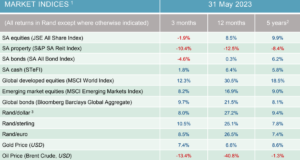Skip to content
Economic and Market Overview – June 2023

May 2023 In Review
-
The Monetary Policy Committee (MPC) of the South African Reserve Bank raised the official interest rate by 0.5%. Higher than-expected global interest rates and persistent inflation led to all five members of the MPC voting for this increase. It takes the repo rate to levels last seen in 2009 when interest rates were raised aggressively to counter the effects of the housing bubble which led to the global financial crisis:

-
Despite the increase in interest rates the rand weakened by -7.7% against the US Dollar in May. This recent pronounced weakness of the Rand reflects a combination of factors including renewed concerns about SA government finances, international reports that the SA government granted Putin and the BRICS leaders diplomatic immunity ahead of the BRICS summit in SA on 22-24 August, and an accusation from the US ambassador in South Africa that arms and ammunition had been loaded onto a Russian military ship docked in Cape Town during December 2022.
-
As if the diplomatic shock to markets was not enough, Eskom announced that it will be a winter of discontent for South Africans. The risk of stage 8 load-shedding is very high, under which there will be power for only 16 hours in a 32-hour cycle. This very likely added to the sell-off in the rand versus foreign currencies.
-
The United State Senate (eventually) passed a bill to suspend America’s debt ceiling until January 2025, allowing the government to resume borrowing money and avoid an imminent sovereign default. America’s upper chamber voted 63-36 to approve the bill; 60 votes were needed to pass it. The deal, on which both Democrats and Republicans had to make compromises, will cut federal spending by US$1.5trn over the next decade, according to the Congressional Budget Office.
-
China has banned US chipmaker Micron Technology’s products for use in its key infrastructure projects, citing security risks. This is the first move against the American semiconductor group and follows a seven-week investigation into Micron by the Cyberspace Administration of China (CAC). CAC stated that Micron “posed significant security risks to China’s critical information infrastructure supply chain”. This level of response was expected by China following Washington’s attempt to restrict China’s access to key technologies and the G7 leaders rebuking China at their meeting over the weekend, citing non-market friendly policies, increased military action in the East and South China Seas, and a poor human rights record. This move is but one example of the increased geo-political intervention in businesses around the world.
Market Performance
The diplomatic fallout between the SA and US governments over allegations that SA sold arms to Russia led to a sell-off in the domestic markets. RMB Markets report that total returns for local equities were driven into negative territory by a confluence of high intensity and frequency of load-shedding and elevated political risks as mentioned above. The Top 40 index returned -3.5% for the month of May. The large-cap index shed 2.8%, mid-caps lost 7.7% and small caps ended 5.1% lower.
Global equity markets were negative everywhere outside of the US, which invokes the (often dubious) adage “sell in May and go away”. The MSCI All Country World Index (ACWI) returned -1.0% in US dollar terms, reflecting negative returns in Europe, the UK, and Asia-Pacific.
In the South African bond market, non-residents turned net sellers of R68.4bn in May following being net buyers of R3.4bn in April. The cumulative outflow for the first five months of 2023 is R216bn, and for the last 12 months, the amount adds up to almost R370bn. The All Bond Index (ALBI) ended May 4.7% lower.
Local property markets did not escape the turmoil and the S&P South Africa REIT index gave up 9.6% for the month.

- Source: Factset
- All performance numbers in excess of 12 months are annualised
- A negative number means fewer rands are being paid per US dollar, so it implies a strengthening of the rand.
Did you know?
One of the first references to inflation comes from the late 15th century when Christopher Columbus returned to Spain from the Americas. He told stories of great empires with enormous riches – particularly in silver. The Spanish then sent fleets of ships across the Atlantic armed with military strength to go and conquer these nations and use the natives to mine the rich silver deposits. A great example of this is Cerro Rico in Bolivia, which is popularly conceived of as being “made of” silver ore. It’s famous for providing vast quantities of silver for the Spanish Empire, most of which was shipped to metropolitan Spain.
This caused a sudden increase in the money available (silver was the most important monetary metal, although gold was used for coins of high denomination) without a commensurate increase in goods and services produced. And there you have it – more money available to pay for the same goods and services, so prices went up. Since the Global Financial Crisis (circa 2008) low-interest rates, combined with government support payments during the Covid-19 pandemic, led to an increase in money supply that was used to pay for goods and services – the supply of which in some instances decreased due to logistical constraints.
More money that’s not accompanied by increases in productivity can therefore contribute to inflation. If, as a country we want to fight high inflation, we need to find a way to be more productive in the future than in the past, and also more productive when measured against our trading partners and global peers. The Reserve Bank cannot fight rising prices on their own – our labour force has a very important role it can play.
Page load link



